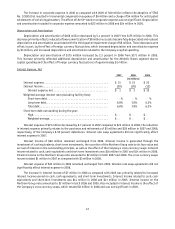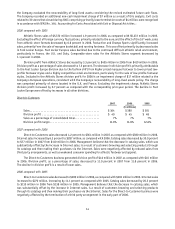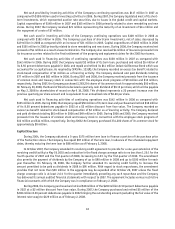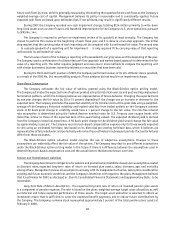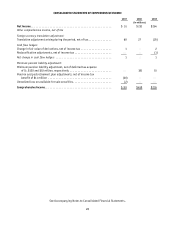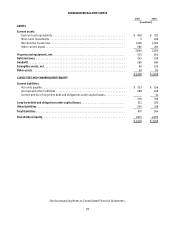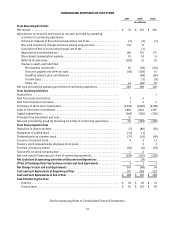Foot Locker 2007 Annual Report Download - page 37
Download and view the complete annual report
Please find page 37 of the 2007 Foot Locker annual report below. You can navigate through the pages in the report by either clicking on the pages listed below, or by using the keyword search tool below to find specific information within the annual report.
21
The weighted-average long-term rate of return used to determine 2007 pension expense was 8.85 percent.
A decrease of 50 basis points in the weighted-average expected long-term rate of return would have increased 2007
pension expense by approximately $3 million. The actual return on plan assets in a given year may differ from the
expected long-term rate of return and the resulting gain or loss is deferred and amortized into the plans’ expense
over time.
Discount Rate - An assumed discount rate is used to measure the present value of future cash flow obligations of
the plans and the interest cost component of pension expense and postretirement income. The discount rate selected
to measure the present value of the Company’s U.S. benefit obligations as of February 2, 2008 was derived using a
cash flow matching method whereby the Company compares the plans’ projected payment obligations by year with the
corresponding yield on the Citibank Pension Discount Curve. The cash flows are then discounted to their present value
and an overall discount rate is determined. The discount rate selected to measure the present value of the Company’s
Canadian benefit obligations as of February 2, 2008 was developed by using the plan’s bond portfolio indices which
match the benefit obligations.
A decrease of 50 basis points in the weighted-average discount rate would have increased the accumulated
benefit obligation as of February 2, 2008 of the pension plans by approximately $27 million and the effect on the
postretirement plan would not be significant. Such a decrease would not have significantly changed 2007 pension
expense or postretirement income.
There is limited risk to the Company for increases in health care costs related to the postretirement plan as,
beginning in 2001, new retirees have assumed the full expected costs and then-existing retirees and future retirees
have assumed all increases in such costs.
The Company expects to record postretirement income of approximately $8 million and pension expense of
approximately $5 million in 2008.
Income Taxes
In accordance with GAAP, deferred tax assets are recognized for tax credit and net operating loss carryforwards,
reduced by a valuation allowance, which is established when it is more likely than not that some portion or all of the
deferred tax assets will not be realized. Management is required to estimate taxable income for future years by taxing
jurisdiction and to use its judgment to determine whether or not to record a valuation allowance for part or all of a
deferred tax asset. A one percent change in the Company’s overall statutory tax rate for 2007 would have resulted in a
$8 million change in the carrying value of the net deferred tax asset and a corresponding charge or credit to income tax
expense depending on whether such tax rate change was a decrease or increase.
The Company has operations in multiple taxing jurisdictions and is subject to audit in these jurisdictions.
Tax audits by their nature are often complex and can require several years to resolve. Accruals of tax contingencies
require management to make estimates and judgments with respect to the ultimate outcome of tax audits. Actual
results could vary from these estimates.
The Company expects its 2008 effective tax rate to be approximately 35.5 percent. The actual rate will primarily
depend upon the percentage of the Company’s income earned in the United States as compared with international
operations.
Discontinued, Repositioning and Restructuring Reserves
The Company exited four business segments as part of its discontinuation and restructuring programs. The final
discontinued segment and disposition of the restructured businesses were completed in 2001. In order to identify
and calculate the associated costs to exit these businesses, management made assumptions regarding estimates of
future liabilities for operating leases and other contractual agreements, the net realizable value of assets held for
sale or disposal and the fair value of non-cash consideration received. The Company has settled the majority of these
liabilities and the remaining activity relates to the disposition of the residual lease liabilities.
As a result of achieving divestiture accounting in the fourth quarter of 2002, the Northern Group note was
recorded at its fair value. The Company is required to review the collectibility of the note based upon various criteria
such as the credit-worthiness of the issuer or a delay in payment of the principal or interest. Future adjustments, if any,
to the carrying value of the note will be recorded pursuant to SEC Staff Accounting Bulletin Topic 5:Z:5, “Accounting



